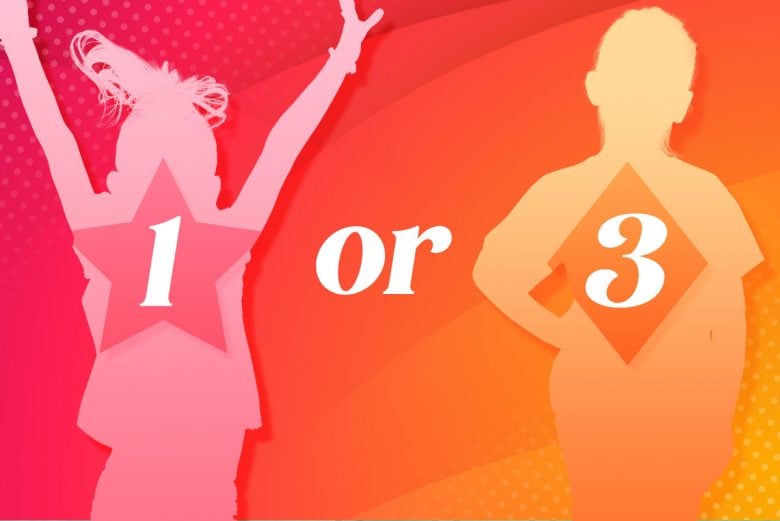
How to feel confident about your child’s Type.
So you know your child has a higher-movement energy. But do they express upward, light Type 1 energy? Or determined, push-forward Type 3 energy?
In this episode, Carol and Anne help you see the difference between Type 1 and Type 3 children in Carol’s Energy Profiling system. They share examples of movement and situations, along with tips of what to look for. Listen in and you’ll have info to help you be sure about your high-energy child’s Type.
This episode’s Parenting Practice
If you are unsure about your child’s Type, set the intention that it will be made clear to you within the week. Pay attention to the variables and differences shared in this episode. And if you already know your child’s Type, ask yourself how you can support your higher-energy children in expressing their fun-loving or determined nature.
Transcript of podcast episode
Carol: Welcome to, The Child Whisperer Podcast. I’m your host, Carol Tuttle, author of the best-selling parenting book, The Child Whisperer. I’m with my co-host, Anne Tuttle Brown. Once you understand the child whispering model of the 4 Types of movement in children, you learn that there are two Types that we consider a higher movement, and more of an extrovert-moving outward energy, and two Types that are considered a more inward, lower-movement energy, which are Types 2 and 4. You’ve got your Type 1 and 3 that are that higher, outward, extrovert movement and Type 2 and 4 that are the lower, more introverted, either calm or more analytical movement. And so a lot of parents will get in that place where they know, well, I have a higher movement child or I have a lower movement child. So this podcast we’re going to look at that variable between is my child a Type 1 energy, upward light, more random, spontaneous, outward, fun-loving movement? Or is my child a Type 3, push forward, determined, more aggressive, more determination type child?
And so, knowing that different quality of movement and what it looks like as it’s expressed from your child, you’ll be able to easily discern, “Oh, that’s Type 1. Oh, that’s Type 3.” Because to me they’re very different. I don’t get confused at all as I have experienced both Type 1 and Type 3 children. And I would use the two…the words that overall generally reference their quality of movement is light versus push. So it’s kind of like this, a light bounce to a kind of a drive, a push.
Anne: Head-down push.
Carol: Yeah. So there is that distinct variable and as they’re living true to themselves that you’d notice this. I think of Teddy, my only Type 1 grandchild. There’s a lightness to him, a flickering…
Anne: Buoyancy. Bounciness.
Carol: Yeah. Just a quality of just whimsy about him. And then I think of my Type 3 grandchildren. There’s just this quality of like a bull, just their head down, [vocalization]…
Anne: That’s the sound we use.
Carol: Here it comes. So let’s look at some examples of that and some other ways you can make that differentiation so it’s very clear to you what’s Type 1. Now the most obvious go to is facial features.
Anne: And we have facial feature videos where we review all of those in detail, so make sure you’ve watched those if it’s been a while, especially if like, you had a baby, and now they’re getting into be toddler, little older and those facial features are more developing, watch those also in body language. Are they bouncing around a lot or do they have a heavier foot plant? You know, that’s been helpful in parents really determining and just seeing what does the whole movement look like because when you’re, you know, seeing the world into these four types for the first time, you can be like, “Okay, I understand like light versus push forward, what does that really look like?” And there was even a parent that said, “I thought my kid was a Type 3. Then I was around Type 3s, you know, and I was like, ‘Oh, that’s Type 3 energy.’ Okay, that makes sense.” And I think sometimes when you have multiple Type 3s in your family, you can be like, “Okay…” It will either help you know, okay, yeah, there’s variables in Type 3, but that’s Type 3 versus Type 1, or it’s new to you. You don’t know that energy as well, you know? So just continue to learn, to, you know, come on the Facebook page and see stories and examples from other parents. That’s always helpful and understand the movement of all the types more fully, and that will help you be able to interpret the movement better. We have a lot of content on the podcast with the difference even in whines, or how they sleep, the different just how they are in utero, there’s a lot of content here that helps you to see the full picture. So if you’re in that, I’m not sure phase, resource those other podcasts.
Carol: Hold that thought. Let’s continue this discussion after a short break.
Announcer: What’s your mom uniform? Yoga pants? Jeans and a tee shirt? As a mom, you’re busy and wardrobe isn’t high on the priority list, but do you ever get tired of feeling blah about how you look? Carol Tuttle’s, Dressing Your Truth program helps you create a personal style that works for you, for your budget, for your family, and for your life. You can look more pulled together in less time. All you need is a little know-how and Carol can show you. Just sign up for a free account at dressingyourtruth.com.
Carol: This parent shared, “I have a Type 1 and a Type 3. My Type 1 is older, so there were a few times I thought maybe he was a Type 3 because he’s so high-movement and physical. But when my daughter was born, the contrast was pretty clear. My son was the cutest little Santa baby, always smiling and bouncing and giggling. My daughter was not that way. She was and is so determined with the loud attention-grabbing voice, and a heavy tread. Her movement is much more firm, and heavy, and determined, while my son’s is wiggly, and not nearly as firm. His movement reminds me of one of those squishy octopus toys wiggling about like jelly. My daughter’s movement is athletic and goal-oriented.” Yeah, there’s sort of this, again, it’s like compare a bouncing ball to dropping, like…okay if you had…
Anne: A weight?
Carol: …a ball in one hand that bounces, and a rock in the other, drop them both and what’s your child? Are they a little more light and light in their footstep and a little more buoyant and the other is just sort of like [vocalization], it lands with a substance to it.
Anne: This is a great example as well from another parent. I wasn’t sure at first if my son was 1 or 3, but what helped me determine Type 1 was the difference between bubble-up energy versus determined-forward energy, which we’ve shared this a lot, so yeah, she’s paying attention. Okay. What’s the difference?
Carol: Yeah, right.
Anne: Also listening to the, “Food Preferences” episode of the podcast totally nailed it as Type 1. Seeing him really take on the other kids’ energies at school and getting feedback like, “Oh, he’ll play with anything, anyone. He does it all. He is so much fun. And then he started going around saying, ‘if it shines, it’s mine.'” That’s so cute.
But yeah, I mean I think too, like little… and don’t hang your hat on this, but what words are people using to describe your children?
Carol: I see that in adults who are like, their nickname is Sonny and I’m like, “Are you kidding me?” “My nickname’s Twinkle.” I’m like…
Anne: “I don’t know what Type I am.”
Carol: “I don’t know what Type I’m at.” I said, “Pretty sure Type 3 is not going to be nicknamed Twinkle.”
Anne: That’s cute. Yeah, definitely. And another parent said their behavior in social settings and I saw that early on when we were developing and you know, we would have kids come to our office and we would study them.
Carol: Right, we used to do that.
Anne: We had like, set up play dates and had kids come and we would observe them.
Carol: Because we wanted to observe their behaviors. It was before I wrote, The Child Whisperer. And we wanted to put them in certain settings.
Anne: And when they’re in…
Carol: And we had those parents taking…they were actually our practicum. They were doing the research for us.
Anne: Oh, they had big pages of like, questionnaires that they would fill out.
Carol: We had them observing their children in settings and various places and log it.
Anne: That’s where all the testimonials in the book come from.
Carol: Yeah, and that’s where I got a lot, a lot of information. And before I wrote the book was from about 30 different family groups who put this all, you know, kind of put their glasses on to see it now. I told them what to look for and what are you seeing? What are you noticing?
Anne: And something I remember that would come out a lot when they’d come into our space was the lower movements 2 and 4, would step back.
Carol: Yes.
Anne: They’d stay by their mom. And the 1s and 3s [crosstalk 00:08:21].
Carol: A lot of time, the Type 4s would go play by themselves. The Type 2 would hover around mom, the Type 2 kids would stick close and take some time.
Anne: Yeah, if there is a group of kids playing…
Carol: They take some time to get integrated. The Type 3s were like…
Anne: The ringleaders?
Carol: Well, they were just louder for sure. Yeah, I’m glad I’m a Type 3 because, you know, I get to be the one that says, “I get it, you know.”
Anne: So that’s one tip, you know, just seeing their behavior outside of the home where they’re the most comfortable, put them in a new setting and that movement could come out more. One more story we’ll share. All the things that would motivate a Type 1 weren’t quite motivating my daughter. She responded more to goals than fun and hated being thwarted once she had an object in mind. And her attitude, I know Type 1s can be sassy, but this one is fierce. I love her Type 3 nature though. When we work together to accomplish things, it’s pretty amazing what we can achieve. Your parenting practice for this week is if you are unsure about your child’s Type, set the intention that it will be made clear to you, and that you will know within…I don’t know how long we want to set the intention for here.
Carol: I’d say within the week they’re going to make it real clear based on this…these variables we’ve taught you.
Anne: Difference in the movement.
Carol: If they’re a Type 3, it’s going to be exaggerated. It’s going to be like in your face, obvious. I’d say, “Oh, there it is.” There’s no question.
Anne: And if you already know their Type, how can you support your higher-movement energy children and expressing their fun-loving or determined nature?
Carol: Thanks for listening. For more support, go to thechildwhisperer.com where you can purchase the book, subscribe to our weekly parenting practice email and find a transcription and audio of “The Child Whisperer Podcast.”
Anne: If you’re listening on iTunes, thank you for leaving a review. If you have a parenting question, please send it to [email protected].



